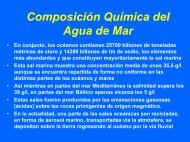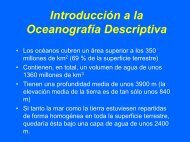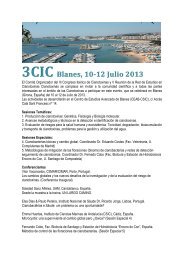El Plan de Acción para el Mediterráneo - CEAB
El Plan de Acción para el Mediterráneo - CEAB
El Plan de Acción para el Mediterráneo - CEAB
Create successful ePaper yourself
Turn your PDF publications into a flip-book with our unique Google optimized e-Paper software.
Historia• 1968 Conferencia Internacional sobre laContaminación <strong>de</strong>l Mar por Petróleo (Roma)• 1969 Conferencia Internacional sobre laProtección <strong>de</strong>l Mar (Milano)• 1969 Xª Sesión <strong>de</strong>l Consejo General <strong>de</strong> las Pescasen <strong>el</strong> <strong>Mediterráneo</strong> (F.A.O.) (Encargó unaEncuesta entre los paises ribereños)• 1970 CGPM/CIESM Informe Provisional sobre <strong>el</strong>Estado <strong>de</strong> la contaminación en <strong>el</strong> <strong>Mediterráneo</strong> (J.Brisou, L. Devèze, O.H. Oren, J. Ros)
Historia (cont)• 1970 Reunión <strong>de</strong>l Scientific Committee onProblems of the Environment (SCOPE)pre<strong>para</strong>ción <strong>de</strong> la cumbre <strong>de</strong> Estocolmo• 1971 CGPM Reunión <strong>de</strong> un Grupo <strong>de</strong> Expertos (J.Brisou, E. du Pontavice, S. Keckes, B. Kimor, O.Lefaucheux, M. Ottaviani, A. Paoletti, J. Ros)• 1971 COI y OMM diseñaron un programa <strong>de</strong>estudio <strong>de</strong> la contaminación marina (MAPMOPP)• 1972 XI Sesión <strong>de</strong>l GCPM aprueba <strong>el</strong> documento:Estado <strong>de</strong> la contaminación marina en <strong>el</strong> Mar<strong>Mediterráneo</strong> y controles legislativos
Historia (cont)• 1972 Cumbre <strong>de</strong> Estocolmo (ONU) sobre <strong>el</strong>Ambiente Humano recomienda un programaglobal <strong>de</strong> monitoreo.• 1974 1st Workshop on Marine PollutionMonitoring (Petroleum) (Maryland) diseñó lastécnicas a seguir <strong>para</strong> <strong>el</strong> monitoreo a escalaglobal.• 1975 COI/OMM iniciaron <strong>el</strong> proyecto globalMAPMOPP.
Historia (cont)• 1976 2nd Workshop on Marine PollutionMonitoring (Petroleum) (Monaco) España nopresentó datos ni estuvo presente• 1976 IOC Manuals and Gui<strong>de</strong>s Nº 7 (Gui<strong>de</strong> toOperational Procedures for the IGOSS PilotProject on Marine Pollution (Petroleum)Monitoring)• 1982 IOC Manuals and Gui<strong>de</strong>s Nº 11 (The<strong>de</strong>termination of petroleum hydrocarbons insediments)
Historia (cont)• 1985 First Report on the State of Pollution of theMediterranean Sea• 1988 Report on the State of Pollution of theMediterranean Sea by Petroleum Hydrocarbons• 1989 Second Report on the State of Pollution ofthe Mediterranean Sea
<strong>El</strong> <strong>Plan</strong> <strong>de</strong> <strong>Acción</strong> <strong>para</strong> <strong>el</strong><strong>Mediterráneo</strong><strong>El</strong> <strong>Plan</strong> <strong>de</strong> <strong>Acción</strong> <strong>para</strong> <strong>el</strong> <strong>Mediterráneo</strong> es un esfuerzomancomunado <strong>de</strong> los 21 estados ribereños y la UniónEuropea con <strong>el</strong> fin <strong>de</strong> afrontar los retos <strong>de</strong> la<strong>de</strong>gradación ambiental en <strong>el</strong> mar, las zonas costeras y<strong>el</strong> interior <strong>de</strong>l territorio y unir <strong>el</strong> <strong>de</strong>sarrollo con lagestión sostenible <strong>de</strong> los recursos, <strong>para</strong> proteger laregión Mediterránea y contribuir a una mejor calidad<strong>de</strong> vida <strong>de</strong> sus habitantes.
MAP Historia• 1975 Se adopta <strong>el</strong> <strong>Plan</strong> <strong>de</strong> <strong>Acción</strong> <strong>para</strong> <strong>el</strong><strong>Mediterráneo</strong>• 1975 Se inicia <strong>el</strong> Programa Científico MEDPOL• 1976 Se firman <strong>el</strong> Convenio <strong>de</strong> Barc<strong>el</strong>ona y dosprotocolos (Vertidos y Emergencias)• 1980 Protocolo sobre la Contaminación <strong>de</strong>s<strong>de</strong>fuentes terrestres• 1982 Se establece la MedUnit en Atenas (Grecia)• 1982 Firma <strong>de</strong>l Protocolo <strong>de</strong> Areas EspecialmenteProtegidas
MAP Historia (cont)• 1994 Firma <strong>de</strong>l Protocolo sobre Exploración yExplotación <strong>de</strong>l fondo marino• 1995 Modificación <strong>de</strong>l Convenio <strong>de</strong> Barc<strong>el</strong>ona• 1995 Modificación Protocolo Vertidos• 1995 Modificación Protocolo Areas Espec. Prot.• 1996 Modificación Protocolo Fuentes terrestres• 1996 Protocolo sobre Movimientos transfronterizos<strong>de</strong> residuos p<strong>el</strong>igrosos y su almacenamiento• 2002 Modificación Protocolo <strong>de</strong> Emergencias
MAP Estructura• Las Partes Contratantes, los Puntos Focales, <strong>el</strong>Bureau,• La MedUnit (MAP/PNUMA)• La Comisión Mediterránea <strong>para</strong> <strong>el</strong> DesarrolloSostenible• <strong>El</strong> Programa científico/técnico MedPol• Los Centros <strong>de</strong> Actividad Regionales• <strong>El</strong> Programa <strong>para</strong> la Protección <strong>de</strong> los LugaresHistóricos
Estados Miembros• España• Francia• Mónaco• Italia• Malta• Eslovenia• Croacia• Montenegro• Albania• Grecia• Turquía• Chipre• Siria• Líbano• Isra<strong>el</strong>• Autoridad Palestina• Egipto• Libia• Tunicia• Arg<strong>el</strong>ia• Marruecos• Comisión Europea
MAP <strong>El</strong>ementos Legales• Convenio <strong>de</strong> Barc<strong>el</strong>ona• Protocolo sobre Vertidos al mar• Protocolo sobre Contaminación por petróleo• Protocolo sobre Fuentes terrestres• Protocolo sobre Areas Especialmente Protegidas• Protocolo sobre Exploración y explotación <strong>de</strong>lfondo marino• Protocolo sobre Movimientos transfronterizos
The State of Marine Pollution inthe Mediterranean Sea andLegislative Controls 1972• CGPM/FAO Studies and Reviews nº 51
There is a difference between the eastern and westernbasins: the eastern Mediterranean is mainly a region of oilproduction, and there are only a few big and w<strong>el</strong>l-<strong>de</strong>finedindustrial centers contributing to contamination by oil. In thewestern Mediterranean the main sources of oil pollution arethe numerous industrial oil processing enterprises and theheavy transshipment of their products.Up to now, Algeria is the only country in the westernMediterranean with important oil production, but in thefuture the exploitation of oil on the Spanish continental sh<strong>el</strong>fmay aggravate the situation in that part of the sea if the<strong>de</strong>posits found near Tarragona and Cast<strong>el</strong>lon turn out to beimportant.
The majority of beaches and harbors, at least in the westernpart of the Mediterranean, is mo<strong>de</strong>rat<strong>el</strong>y or sever<strong>el</strong>ypolluted. In some parts fishing nets could no longer be usedas they had become complet<strong>el</strong>y covered with tar.Large quantities of tar-like oil residues have been founddrifting on the surface of nearly all Mediterranean regions,particularly in the middle of the Gulf of Sidra, where their<strong>de</strong>nsity has been measured to reach 0.5 ml per square meter.Cyprus: Oil pollution is becoming a major littoralproblem. All beaches are more or less polluted, thoughsome parts of the coast are particularly affected due toprevailing winds and current patterns along the coast.France: No large tanker acci<strong>de</strong>nt has happened sofar, but numerous acci<strong>de</strong>nts of local importance contributedto the oil pollution along the coast.
Isra<strong>el</strong>: Oil pollution is of more than local importancedue to the current system in the Levant basin and thepredominant westerly winds in that area. There have beenonly a few acci<strong>de</strong>nts which were of minor importance.However, when a pip<strong>el</strong>ine ruptured near the coastline, greatquantities of oil were driven to the beaches.Italy: Nearly the whole coast is affected. In 1967 onethird of the coastal communities reported pollution by oilresidues from refineries or ships. Areas with a very high<strong>de</strong>gree of oil pollution are the Gulf of Genoa, La Spezia,Livorno, Rome, the Gulf of Naples, Falconara, Ravenna,Marghera and the coasts of Sicily and Sardinia. Particularlysevere effects of oil pollution have been observed in the Gulfof Trieste, caused by refineries and industrial installations inthat area.
Lebanon: Although the oil contamination, at present, hasonly local importance, it has been stated that the pollution ofbeaches is continuously growing.Spain: No severe acci<strong>de</strong>nts have happened so far.However, many coastal communities complain aboutintolerable pollution of the beaches: 44 % in Catalonia, 80 %between the Ebro river and the Cape of Gata, and 50 % alongthe southern coast of Spain.Tunisia: Evi<strong>de</strong>nt oil pollution of the beaches has beenobserved along the coasts of the whole country. Although ithas not yet reached the state of a “black ti<strong>de</strong>”, it has beencontinuously growing during the past and there is a real riskof adverse effects on tourism in the future.
Turkey: Oil residues originating from ballast waterand other oily mixtures discharged from ships can frequentlybe observed in the Bosphorus and the Sea of Marmara.Yugoslavia: No tanker acci<strong>de</strong>nt has happened so far.However, oil pollution of the beaches is continuouslygrowing, in particular in the northern parts of the AdriaticSea.
Controles legislativos en España 1972(agua dulce)Ley <strong>de</strong> Aguas (13 Junio 1879) daba po<strong>de</strong>res a losgobernadores provinciales, como medida temporal, <strong>para</strong>obligar a las indunstrias a <strong>para</strong>r la <strong>de</strong>scarga <strong>de</strong> substanciasdañinas <strong>para</strong> la salud <strong>de</strong> los humanos o <strong>de</strong> la vegetación en<strong>el</strong> agua sin las necesarias precauciones purificadoras. Si talesmedidas no se hubieren tomado en seis meses, seconsi<strong>de</strong>raba a la persona encargada como habiendorenunciado a sus <strong>de</strong>rechos <strong>de</strong> continuar las operaciones.Decreto <strong>de</strong> 16 Noviembre 1900 completaba lo anteriorprohibiendo la <strong>de</strong>scarga en ríos y bahías <strong>de</strong> aguas usadas<strong>para</strong> <strong>el</strong> lavado <strong>de</strong> minerales u otros usos industriales. Tales<strong>de</strong>scargas eran solo permitidas si las mismas no interferíancon la pesca, la navegación o cualquier otro uso. <strong>El</strong>lo teníaque justificarse ante <strong>el</strong> gobierno civil y otros organismos.
Decreto <strong>de</strong> 6 Abril 1943 enmendado por otro <strong>de</strong> 13 Agosto1966 prohibía absolutamente cualquier <strong>de</strong>scarga <strong>de</strong> residuos oefluentes tóxicos sin purificación previa aprobado por laDirección <strong>de</strong> Pesca.Decreto <strong>de</strong> 14 Noviembre 1958 autorizaba a la policía <strong>de</strong>aguas evitar cualquier <strong>de</strong>scarga p<strong>el</strong>igrosa <strong>para</strong> la salud humanapor razón <strong>de</strong> su contenido bacteriano. Un plan <strong>de</strong> purificación<strong>de</strong>bía ser ejecutado por industrias, sanatorios, hospitales yhot<strong>el</strong>es.Or<strong>de</strong>nanza <strong>de</strong> 4 Septiembre 1959 obligaba a lasconfe<strong>de</strong>raciones a clasificar los ríos en cuatro categorías:protegidos, controlados, normales y abiertos a usosindustriales. Las <strong>de</strong>scargas eran clasificadas como inofensivas,sospechosas o p<strong>el</strong>igrosas.
Decreto <strong>de</strong> 8 Octubre 1959 autorizaba a las Confe<strong>de</strong>racioneshidrográficas a permitir ciertos tipos <strong>de</strong> <strong>de</strong>scargas y mantener<strong>el</strong> control <strong>de</strong> los ríos. <strong>El</strong> Gobierno <strong>de</strong> España subsidiaba a lasindustrias hasta un 50% <strong>de</strong>l coste <strong>de</strong> las instalaciones <strong>para</strong> <strong>el</strong>control <strong>de</strong> la contaminación.
Controles legislativos en España 1972(aguas marinas)Al parecer no existía ninguna regulación aunque sí unaOr<strong>de</strong>nanza <strong>de</strong> 1 Junio 1963 que contenía especificaciones<strong>para</strong> la construcción <strong>de</strong> petroleros. Todos los buques <strong>de</strong> más<strong>de</strong> 20000 tm <strong>de</strong>bían tener tanques <strong>para</strong> <strong>el</strong> almacenamiento <strong>de</strong>agua <strong>para</strong> limpiar los <strong>de</strong>más tanques y todos los buques <strong>de</strong>más <strong>de</strong> 500 tm <strong>de</strong>bían estar equipados con un sistema <strong>de</strong><strong>de</strong>cantación <strong>para</strong> la se<strong>para</strong>ción <strong>de</strong>l petróleo y <strong>el</strong> agua. La leytambién obligaba a la construcción en todos los puertos <strong>de</strong>instalaciones <strong>para</strong> la recolección <strong>de</strong> aceites residuales. Esamisma Or<strong>de</strong>nanza obligaba a las refinerías o compañíasusuarias a establecer instalaciones fijas o flotantes <strong>para</strong>recoger los residuos <strong>de</strong> los petroleros.
Global Oil Pollution 1978Results of MAPMOPP, IOC-WMO PilotProject on Marine Pollution (Petroleum)Monitoring (1975 - 1978)
Oil Slicks: A <strong>de</strong>tailed analysis on the basis of 2º by 2º squares wascarried out on the data from the Mediterranean Sea. Except for a fewareas, surface slicks were reported in more than 10% of the observationsma<strong>de</strong> throughout the region. These data provi<strong>de</strong> convincing evi<strong>de</strong>nce ofextensive surface oil pollution in the Mediterranean Sea.
Diss./dispersed:Although datawere poorlyspaced and manycorrespon<strong>de</strong>d tocoastal areas andharbors, thegeneral trend wasclearly illustrated,that is, the lev<strong>el</strong> ofpollution washighest in the eastand northeast andlowest in thecentral andwestern areas.
Floating tar: Com<strong>para</strong>tiv<strong>el</strong>y high concentrations of tar werepresent in the eastern Mediterranean Sea, particularly in areaswhere discharges of tank washings are permitted from tankersthat do not employ load-on-top techniques.
First Report on the State ofPollution of the MediterraneanSea 1985UNEP/IG.56/Inf. 4/1985Based on final reports of Bas<strong>el</strong>inestudies and monitoring of oil andpetroleum hydrocarbons in marinewaters (MED POL I)MAP Technical Reports Series Nº 1
Generally, the concentration of dissolved and dispersedpetroleum hydrocarbons were less than 5 µg/l in the region.However, heavily contaminated areas were frequently observedoutsi<strong>de</strong> industrialized zones along the coast. Similarly, alongthe shipping lanes in the eastern regions, where discharges ofoil from ships were until recently permitted, higher values of upto 50 µg/l were reported.Results indicate high values of petroleum hydrocarbonconcentrations in sediments near oil terminals and river mouths.In the absence of systematic and com<strong>para</strong>ble results, higherconcentrations among fishes are found near major rivers andindustrial sources.The figures for oil spills show a noticeable and virtuallycontinuous <strong>de</strong>crease in the total number of oil spills recor<strong>de</strong>d.However, the risk is always there.
Report on the State of Pollutionof the Mediterranean Sea byPetroleum Hydrocarbons 1988MAP Technical Reports Series Nº 19
• The available data base on hydrocarbon lev<strong>el</strong>sshows that most of the observations were fromcoastal and near shore areas with a lack of data inthe open sea.• Most of the data are not com<strong>para</strong>ble since theywere not obtained by intercalibrated methods.• Very little information was available on thebiological effects.• A r<strong>el</strong>iable scientific evaluation of the state ofpollution and the possible associated biologicaleffects cannot be ma<strong>de</strong> with confi<strong>de</strong>nce on thebasis of existing data.
Second Report on the State ofPollution of the Mediterranean Sea1989MAP Technical Reports Series Nº 28
Concentraciones <strong>de</strong> hidrocarburos alifáticosdisu<strong>el</strong>tos/dis- persos en <strong>el</strong> agua <strong>de</strong> mar por <strong>de</strong>bajo<strong>de</strong> 0.5 µg/l se han encontrado en alta mar, sobretodo en <strong>el</strong> <strong>Mediterráneo</strong> Occi<strong>de</strong>ntal. Sin embargo,valores uno o hasta dos ór<strong>de</strong>nes <strong>de</strong> magnitud másaltos han sido encontrados en diversas áreas (entreCast<strong>el</strong>lón y Cartagena, en <strong>el</strong> Adriático y <strong>el</strong> Egeo,en la parte central y en las aguas próximas a Libiay a Turquía).Para <strong>el</strong> alquitrán flotante, valores entre 0.5 y 16mg/m 2 se han medido en diversas áreas <strong>de</strong> alta mar,particularmente en <strong>el</strong> <strong>Mediterráneo</strong> Oriental.
<strong>El</strong> <strong>Mediterráneo</strong> no ha sufrido muchos acci<strong>de</strong>ntesgraves con vertido <strong>de</strong> hidrocarburos pero sí estáexpuesto a muchos vertidos intencionales.Contaminación crónica existe en las principalesrutas <strong>de</strong> los petroleros, particularmente en <strong>el</strong><strong>Mediterráneo</strong> Oriental.Aunque no existe una estadística fiable, seconsi<strong>de</strong>ra que estos vertidos son mucho másimportantes que los causados por los gran<strong>de</strong>sacci<strong>de</strong>ntes.
Una estimación basada en la práctica <strong>de</strong> lospetroleros locales <strong>de</strong> 0.5 a 1 millón <strong>de</strong> ton<strong>el</strong>adas poraño vertidas en <strong>el</strong> <strong>Mediterráneo</strong> seguía siendoválida.No obstante, la entrada en vigor <strong>de</strong>l ConvenioMARPOL (Octubre 1983) pudo tener comoconsecuencia una reducción significativa <strong>de</strong>lpetróleo vertido al mar <strong>de</strong> hasta <strong>el</strong> 50 %.
En <strong>el</strong> período 1977 - 1987 un total <strong>de</strong> 94 acci<strong>de</strong>ntesfueron informados al Centro Regional <strong>de</strong> Luchacontra la Contaminación por Petróleo (ROCC) <strong>de</strong>los cuales un 59 % causaron vertidos <strong>de</strong> petróleo <strong>de</strong>distinta consi<strong>de</strong>ración.Cuatro vertidos causaron un vertido acumulado <strong>de</strong>más <strong>de</strong> 200000 ton<strong>el</strong>adas.Por otra parte, 46 vertidos <strong>de</strong> hasta 1000 m 3tuvieron lugar <strong>de</strong> forma acci<strong>de</strong>ntal o <strong>de</strong>liberada enoperaciones <strong>de</strong> diversa índole.
<strong>El</strong> Centro RegionalOMI/PNUMA <strong>de</strong> Intervención <strong>de</strong>Urgencia contra laContaminación Acci<strong>de</strong>ntal(REMPEC)Mano<strong>el</strong> Island (Malta)http://www.rempec.org
HistoriaEn 1948 la ONU creó la Organización MarítimaConsultiva Intergubernamental (OMCI/IMCO) aunquehasta 1959 no entró en funciones. En 1954 <strong>el</strong> gobiernobritánico organizó una conferencia internacional queadoptó <strong>el</strong> Convenio Internacional sobre la Prevención <strong>de</strong>Contaminación <strong>de</strong>l Mar por Petróleo (OILPOL) y acordóque la OMCI fuese responsabilizada <strong>de</strong>l seguimiento <strong>de</strong>dicho Convenio.<strong>El</strong> acci<strong>de</strong>nte <strong>de</strong>l Torrey Canyon en 1967 dio un nuevo giroal concepto <strong>de</strong> contaminación y en 1973 se adoptó unnuevo convenio (MARPOL) que cubría otros aspectos <strong>de</strong>la contaminación <strong>de</strong>l mar.
Historia (cont)Las Partes Contratantes <strong>de</strong>l Convenio MARPOL fueronconscientes <strong>de</strong> la peculiaridad <strong>de</strong>l Mar <strong>Mediterráneo</strong> que<strong>de</strong>s<strong>de</strong> <strong>el</strong> principio fue consi<strong>de</strong>rado una Area Especial en lacual las medidas obligatorias <strong>de</strong> protección fueron másestrictas.Particularmente importantes fueron las normas <strong>de</strong>MARPOL 73/78 que obligaban a retener a bordo losresíduos óleos durante las operaciones normales <strong>de</strong> losbuques y en particular <strong>de</strong> los petroleros cuyo diseño tuvoque ser modificado <strong>para</strong> minimizar los vertidosoperacionales (intencionados).
Historia (cont)<strong>El</strong> REMPEC fue primero establecido en 1975 comoCentro Regional <strong>de</strong> Lucha contra la Contaminación porHidrocarburos <strong>de</strong>l Petróleo (ROCC) según acuerdo <strong>de</strong> lasPartes Contratantes y <strong>de</strong>l PNUMA y la OMI con <strong>el</strong>gobierno <strong>de</strong> Malta.Sus términos <strong>de</strong> referencia fueron posteriormentemodificados <strong>para</strong> abarcar todos los aspectos <strong>de</strong> lacontaminación <strong>de</strong>l Mar <strong>Mediterráneo</strong> por acci<strong>de</strong>ntes y laintervención urgente.
Sistema <strong>de</strong> Información Regional<strong>El</strong> REMPEC recoge informes sobre inci<strong>de</strong>ntes que causan opue<strong>de</strong>n causar <strong>de</strong>rrames <strong>de</strong> petróleo <strong>de</strong>s<strong>de</strong> 1977.311 inci<strong>de</strong>ntes han sido tabulados entre agosto <strong>de</strong> 1977 ydiciembre <strong>de</strong> 2000 <strong>de</strong> los cuales 156 resultaron en vertidos <strong>de</strong>petróleo.La cantidad total vertida entre 1981 y 1990 fue <strong>de</strong> 36476 tmmientras que entre 1991 y 2000 fue <strong>de</strong> 21667Sin embargo, sólo dos acci<strong>de</strong>ntes registrados entre 1981 y2000 resultaron en vertidos <strong>de</strong> más <strong>de</strong> 10000 tm•Cavo Cambanos•Haven18000 tm10000 - 144000 tm
Sistema <strong>de</strong> Información RegionalOtros dos acci<strong>de</strong>ntes tuvieron lugar fuera <strong>de</strong>l <strong>Mediterráneo</strong>:•Sea Spirit•Hesperusaunque los productos vertidos alcanzaron a entrar en este Marafectando las costas <strong>de</strong> España, Marruecos y Arg<strong>el</strong>ia.
Alertas y Acci<strong>de</strong>ntes<strong>El</strong> Protocolo <strong>de</strong> 1976 sobre Emergencias estipulaba que lasPartes Contratantes se comprometían a establecer y mantenerplanes <strong>de</strong> contingencia y medios <strong>para</strong> combatir lacontaminación marina, <strong>el</strong> seguimiento <strong>de</strong> esta contaminación y<strong>el</strong> intercambio <strong>de</strong> información importante <strong>para</strong> la pre<strong>para</strong>ción yrespuesta inmediata. También <strong>de</strong>bían mantener a través <strong>de</strong>lROCC/REMPEC un sistema <strong>de</strong> comunicación fiable y unsistema <strong>de</strong> notificación rápida <strong>de</strong> los inci<strong>de</strong>ntes contaminantes.También trataba la obligación <strong>de</strong> evaluar a<strong>de</strong>cuadamente lanaturaleza y extensión <strong>de</strong>l inci<strong>de</strong>nte y tomar medidas <strong>para</strong> sureducción y <strong>de</strong> informar <strong>de</strong> todo <strong>el</strong>lo a los <strong>de</strong>más Países.En 1987 se extendió <strong>el</strong> mandato <strong>de</strong>l ROCC/REMPEC <strong>para</strong>cubrir otras substancias p<strong>el</strong>igrosas.
Conclusión•Los primeros estudios en la década <strong>de</strong> 1970 apuntaban al<strong>Mediterráneo</strong> como una <strong>de</strong> las regiones más contaminadas porpetróleo <strong>de</strong>l planeta.•Los estudios científicos llevados a cabo hasta 1988 no fueronconclusivos por falta <strong>de</strong> datos en general y pobreza metodológica.•<strong>El</strong> sistema en vigor en <strong>el</strong> <strong>Mediterráneo</strong>, tanto jurídico comotécnico, es y ha sido siempre puntero.•No parece que España tenga un <strong>Plan</strong> <strong>de</strong> Contingencia Nacional•Aun cuando en cualquier momento estas conclusiones pue<strong>de</strong>nverse radicalmente alteradas, se pue<strong>de</strong> <strong>de</strong>cir que, hasta <strong>el</strong>presente, <strong>el</strong> Mar <strong>Mediterráneo</strong> se ha visto libre <strong>de</strong> gran<strong>de</strong>sacci<strong>de</strong>ntes con vertidos importantes.
Gracias
















